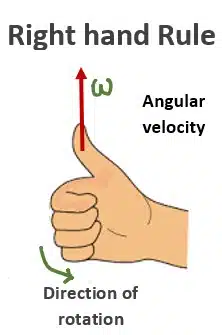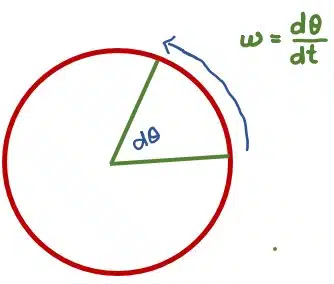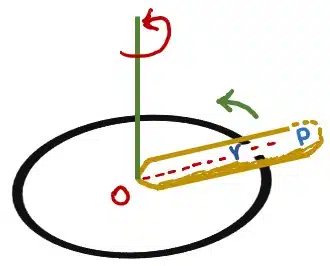Angular Velocity | Angular Acceleration
Angular velocity is the velocity of a body moving in a circular path. When a body rotates in a circle then its motion is angular motion and its displacement is angular displacement.
The rate of change of angular displacement is called angular velocity. The rate of change of angular velocity is called angular acceleration.
Download the pdf notes of Angular Velocity class 11 Physics
Angular velocity
Angular velocity can also be defined as Angular displacement per unit of time is called angular velocity. It is denoted by ω (omega) and is a vector quantity.
ω = Angular displacement/time
The direction of Angular Velocity
Its direction is determined by the Right-Hand rule which is along the axis of rotation.

If we curl the finger in the direction of angular displacement then the thumb will give the direction of angular Velocity.
Unit of Angular Velocity
In the Sl system, it is measured in rad/sec. Sometimes it is also measured in deg/sec, rev/sec, or rev/min. The dimension of angular velocity is [T¹].
Average Angular Velocity:
It is the ratio of the total change in angular displacement to the total time taken.

if Δθ is the change in angular displacement during the time interval Δt, the average angular velocity ” ωav” during this interval is given by
ωav = Δθ/ Δt
Instantaneous Angular Velocity:
The angular velocity of an object at a particular instant of time is called instantaneous angular velocity. The limit of the ratio Δθ/ Δt as Δt approaches zero is called instantaneous velocity.
ωins = lim Δt —0 Δθ/Δt
Angular Acceleration
The rate of change of angular velocity is called angular acceleration. Or a change in angular velocity per unit time is called angular acceleration.
It is denoted by α and is a vector quantity.
The Direction of Angular Acceleration
Its direction is determined by the hand rule which is along the axis of rotation.
If we curl the finger in the direction of rotation then the thumb will be in the direction of angular acceleration.
Angular Acceleration Unit
In S.I. units, it is measured in rad /sec. Other units are deg/sec2. It has a dimension of [T2].
Average angular acceleration:
It is the ratio of the total change in angular velocity to the total time taken. If ωi and ωf are the values of the instantaneous velocity of the rotating body at instants ti and tf.
The average angular acceleration is given by
αav= ωf – ωi / tf – ti
Instantaneous Angular Acceleration:
The angular acceleration of an object at a particular instant is called Instantaneous angular acceleration.
The limit of the ratio Δω/Δt as Δt approaches zero is called instantaneous angular acceleration.
αins = lim Δt —0 Δω/Δt
Rotational Motion
Consider a point P on a rigid body. Line OP is the perpendicular drawn from P on the axis of rotation O. It is called a reference line.

As the body rotates, the line OP also rotates with it with the same angular velocity and angular acceleration. Thus the rotation of a rigid can be described by the rotation of the reference line OP. In the future, while dealing with the rotational motion of a rigid body, we will replace it with its reference line OP.
Related FAQs
Is angular velocity the same as angular acceleration?
The rate of change of the angle per unit time or radians per second is referred to as angular acceleration. While the rate of change of angular displacement is called angular velocity.
What does angular acceleration depend on?
Angular acceleration is proportional to net torque and inversely proportional to rotational inertia.
Why angular velocity is a vector?
Angular velocity is a vector quantity and has both a magnitude and a direction. The direction is the same as the angular displacement direction from which we defined the angular velocity.







Leave a Reply